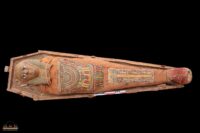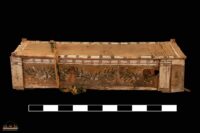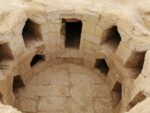 The Egyptian archaeological mission has unearthed a monumental funerary building and mummy portraits from the Ptolemaic and Roman periods at the Garza archaeological site in Fayoum, about 37 miles south of Cairo, Egypt. These are the first mummy portraits found in an archaeological excavation at Fayoum since Flinders Petrie found 146 of them in a Roman-era necropolis in 1910-11.
The Egyptian archaeological mission has unearthed a monumental funerary building and mummy portraits from the Ptolemaic and Roman periods at the Garza archaeological site in Fayoum, about 37 miles south of Cairo, Egypt. These are the first mummy portraits found in an archaeological excavation at Fayoum since Flinders Petrie found 146 of them in a Roman-era necropolis in 1910-11.
The village of Garza was founded as Philadelphia under the reign of Ptolemy II Philadelphus (309–246 BC). Excavations have been ongoing since 2016, and have unearthed numerous artifacts dating from its founding to Roman rule in the 3rd century A.D.
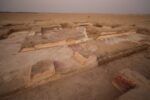 The building is in the style of a funerary home. It was built of stone blocks with chamber tombs built into or cut out of the walls. The floor was paved with lime slabs and painted in alternating colors like a checkerboard. On the southern side is a colonnaded hall in which the remains of four columns were discovered. A small, narrow street leads to the building.
The building is in the style of a funerary home. It was built of stone blocks with chamber tombs built into or cut out of the walls. The floor was paved with lime slabs and painted in alternating colors like a checkerboard. On the southern side is a colonnaded hall in which the remains of four columns were discovered. A small, narrow street leads to the building.
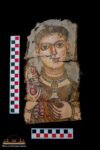 Inside the funerary building, the mission team uncovered a number of coffins in both Egyptian humaniform style and in Greek style with a gabled roof. One of the humaniform coffins is covered with a rare example of a cartonnage mask with wig in the ancient Egyptian style that dates to the 1st century B.C. The mummy portraits include a beautiful panel painting of a young woman with elaborately braided and bejeweled hair wearing earrings, two necklaces, rings, bracelets. She holds a rose garland in one hand and a small vessel in the other. The vessel type is of a type that was produced in ancient Garza.
Inside the funerary building, the mission team uncovered a number of coffins in both Egyptian humaniform style and in Greek style with a gabled roof. One of the humaniform coffins is covered with a rare example of a cartonnage mask with wig in the ancient Egyptian style that dates to the 1st century B.C. The mummy portraits include a beautiful panel painting of a young woman with elaborately braided and bejeweled hair wearing earrings, two necklaces, rings, bracelets. She holds a rose garland in one hand and a small vessel in the other. The vessel type is of a type that was produced in ancient Garza.
What was discovered at the site illustrates the diversity and difference in the accuracy and quality of the embalming process during the Ptolemaic and Roman eras, which indicates the economic stature of the deceased, starting from high-quality embalming to simple burials.
A rare terracotta statue of the goddess Isis-Aphrodite was also found in one of the burials inside a wooden coffin.
Also discovered was a set of records made of papyrus with inscriptions in the Demotic and Greek scripts indicating the social, economic and religious conditions of the inhabitants of the region during that period.
